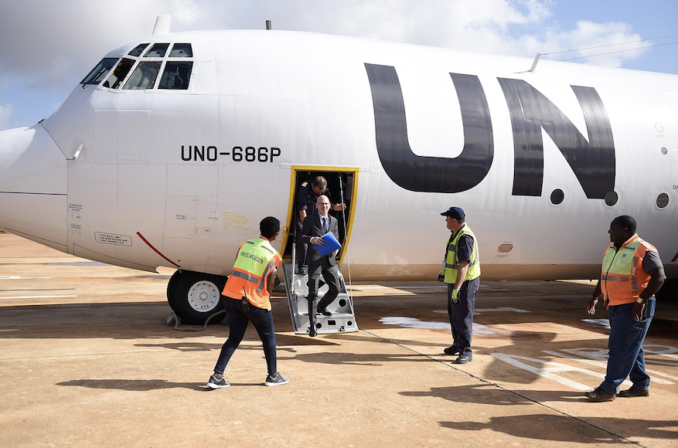Q: Isn’t there a better way to control these gunmen?
A: Somebody did suggest one – carpet bomb Somalia with ecstasy, because it curbs hunger and makes everyone love each other. It’s not a bad idea…
UN SRSG Mohamed Sahnoun
Somalia’s famine was finally “discovered” by Lame Stream in August 1992 largely due to aid workers and independent journalists who remained on the ground forcing the UN to take notice. Somalia’s gunmen still reigned, patrolling the streets. They dictated the rules for an increasing number of new aid agencies, forcing upon them the dilemma: how to save the dying without subsidising the very gunmen who caused it?
Farah Aidid controlled the port and were part of the 2-day clash over looting 8,000MT of food at a nearby warehouse to win its share. The famine alarm bells that rang back in December 1991. As the famine began to spiral out of control, Aidid made sure his promise to central region elders to finally removing Siad Barre. Aidid launched a final offensive mid-March 1992. By April, Barre was forced to flee to Kenya, where he and 20 aides took “temporary asylum” in Nairobi’s luxurious Safari Park hotel on Thika road. Costing US$1,800 per day, Barre was granted exile in Nigeria. Big Mouth died on 2nd January 1995.
Aidid’s triumph over Barre resounded across Somalia. It confirmed his status as chief warrior, enabling him to create a political alliance of southern and central clans, enhancing his claim to rule. Ali Mahdi’s Abgal subclan was furious at him for refusing to take part in the fighting to remove Barre.
Despite victory, the results of the famine continued to increase. Africa had not been witness to widespread starvation since the Ethiopian famine of 1984-85. The problem was not always the lack of food but the inability to get it to the hungry – the hallmark of Somalia’s famine. While feeding centres doubled in number, ships carrying food were often turned away from Mogadishu port by mortar fire, as rival militias fought for spoils before they even arrived.

Ambassador Mohamed Sahnoun,
Anonymous photographer – Public domain
In July 1992, UN chief Boutros Ghali publicly warned the world was, “Fighting a rich man’s war in Yugoslavia while not lifting a finger to save Somalia from disintegration.” What the UN, at the time, did get right was appointing Mohamed Sahnoun as SRSG. An Algerian diplomat, he was the only senior UN official who understood the unique requirements of Somali peacemakers, elders and warriors.
He understood the power politics, their needs and expectations of those with guns and worked to create an alternative leadership. He was outspoken, and his frankness was able to briefly improve UN reputation in Somalia.
Negotiations to bring the first 500 UN troops, approved by UN Security Council in April 1992, dragged on for weeks, as warlords angled for advantage. Xenophobia and clannism overrode all. Aidid finally accepted in August 1992. The symbolic Pakistani force of 500 blue berets, known as UN Operation in Somalia [UNOSOM I] began arriving in September. They were armed for self-defence, but eventually hired Somali gunmen to guard their positions.
Complicating matters further, in August both Aidid and Sahnoun heard over the BBC World Service, without first being consulted by UN HQ, that 3,000 more “peacekeeping” troops would be sent, with or without the approval of the warlords. Aidid knew that such a force would threaten his dominance, and he immediately organised demonstrations against it. This defence mechanism against outsiders, is a national characteristic.
SRSG Sahnoun knew that Somalis considered the unwanted UN presence as new series of “targets wearing blue berets”.
Sahnoun, despite his progress with all factions, repairing damage caused by his predecessors, was dismissed in October 1992. His departure was the final blow to UN credibility in Somalia. Boutros Ghali criticised him for making high-profile, public complaints about UN incompetence, at all levels.

The UN Special Representative for Somalia,
UNSOM-SCPAG – Licence CC BY-SA 2.0
The stumbling former envoy James Jonah who had been subsequently promoted to Under Sec Gen [UNSG] in New York, was largely responsible for leaving Sahnoun without resources and had helped orchestrate his dismissal out of spite to cover his own incompetence. Like Somalis, Sahnoun became a victim of UN bureaucracy and incompetence.
© AW Kamau 2023



